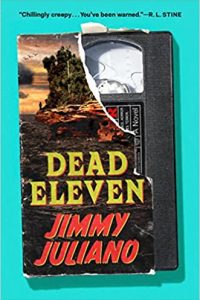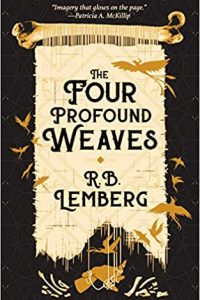Paul Di Filippo Reviews How High We Go in the Dark by Sequoia Nagamatsu
 How High We Go in the Dark, Sequoia Nagamatsu (William Morrow 978-0063072640, hardcover, 304pp, $27.99) January 2022.
How High We Go in the Dark, Sequoia Nagamatsu (William Morrow 978-0063072640, hardcover, 304pp, $27.99) January 2022.
Sequoia Nagamatsu’s debut novel, How High We Go In the Dark, is in the nature of a “fixup,” that time-honored and actually quite often innovative structure that is assembled from previously published pieces which were deemed at the time to be independent and self-sufficient tales. I’m not sure if these earlier segments have received much massaging, and there is some new material to be sure. But basically the book’s narrative arc consists of vignettes separated by fairly significant time gaps, detailing a future history seen in spurts, with recurring characters. The assemblage is nicely done and satisfying, but resemblance to the off-the-shelf narrative unities of a traditional novel are tenuous. So the reader needs to be aware of that.
In addition to its slightly unconventional format, the book boasts an appealing heterogeneity of modes. It opens with an almost Lovecraftian vibe (weird ancient doings in a cold climate); moves for a time through some distinctly George Saunders-style shenanigans (melancholy satire); launches into Poul-Anderson-by-way-of-Carter-Scholz SF (to the stars, in desperation); returns to some humanist SF riffs a la Richard Powers (the wisdom of children in a new era); then ends with Strossian speculations (our descendants will be different). It’s a wild ride, but somehow hangs together into an organically aesthetic whole, quite accomplished and ambitious. Readers willing to ride the rollercoaster will enjoy every minute.
The first section, “30,000 Years Beneath a Eulogy”, is set circa 2030, and details a Siberian scientific expedition which has uncovered an ancient quasi-humanoid specimen dubbed “Annie.” Our narrator (almost all the sections get a different first-person voice) is Dr. Miyashiro, whose daughter, Clara, another scientist, has already died on the expedition. Stepping dutifully into her shoes, he ruminates on the fickleness of fate and history and the dubious future of humanity. Back home, his wife is taking care of their orphaned granddaughter, Yumi (an important person who will resurface as an adult later). Alas, Annie’s corpse contains a plague virus that is set loose in the world. The rest of the novel will be contoured by the plague’s devastating progress until its ultimate defeat.
This disease unfortunately prefers juvenile victims, and has the effect of unleashing each cell’s totipotency, allowing lungs to become livers, hearts to become brain matter, etc. There also seems to be an almost paranormal aspect to the disease: “organs…transformed into vague approximations of other bodily organs or—even more bizarrely—into globs of light.” Comparisons here to Ben Marcus’s The Flame Alphabet would not be off-target.
Next, in “City of Laughter”, we see society’s partial response to the plague: the establishment of “euthanasia parks,” where child victims can have a fun time before receiving a lethal mercy shot. The influence of Saunders is strongest here. Jumping to the chapter titled “Pig Son,” we find the highly topical matter of raising genetically modified pigs for organ transplantation among the plague victims. Our protagonist this time, one of the scientists in charge of the project, is startled to encounter a single pig—Snortorious—who has spontaneously acquired the ability to talk. The relationship between man and swine illuminates the dire choices that face all this era’s individuals.
The opening to “Elegy Hotel” should give you a feel for Nagamatsu’s predominant voice and style. His characters mostly exist in states of rueful, knowing, hurting, reluctant acceptance, out of which dire and pallid circumstances they can often prod them into redemptive actions.
They gave bereavement coordinators like me studio apartments on the top floors of the elegy hotel. Some of my colleagues had naive ideas about saving the world, but we were really just glorified bellhops for the mountain of Arctic plague victims awaiting cremation, for the families who wanted to curl up in a suite with the corpses of their loved ones and heal…. I kept my head down, barely speaking about my past, carting bodies from California king beds to the crematorium.
“Speak, Fetch, Say I Love You” concerns a repairer of robot dogs and the way in which the family’s own cyberpet helps with the death of the narrator’s wife. A Flowers for Algernon vibe permeates “Songs of Your Decay”, wherein a forensic doctor and his dying human lab subject establish an unanticipatedly deep bond. “Life Around the Event Horizon” chronicles the breakthrough discovery of how to create mini-black hole power sources—unfortunately, one gets lodged in the narrator’s skull. Notwithstanding that tragedy, the chapter titled “A Gallery a Century, A Cry a Millennium” uses the new tech to launch a generation ship to the stars, and we get the multi-millennia diary of its expedition. After a couple of more sections detailing further incidents back on Earth, the final chapter, “The Scope of Possibility”, adopts a hitherto-secret cosmic perspective to cast all the past events into a broader context where the arc of history has a goal.
Nagamatsu’s ability to evoke many distinctive and distinct characters is powerfully on display. His speculative abilities are top-notch, as he examines all the macro- and micro-effects of his prime story engine, the plague. (“I see him studying the tiny pink supernovas on her face, a side effect of one of the most recent experimental drugs used to manage the spread…”) His prose, while not showy, often attains poetic liftoff. (“Seeds did not launch into the sky or leave a plume of smoke like a rocket. The cradles that held them disrupted the fabric of space, opening a corridor to the target star system.”) Taken together, his talents make for a primo SF writer whose future path will assuredly lead to many more unique wonders.
Readers who enjoyed Matt Bell’s Appleseed will find similar rewards here.
 While you are here, please take a moment to support Locus with a one-time or recurring donation. We rely on reader donations to keep the magazine and site going, and would like to keep the site paywall free, but WE NEED YOUR FINANCIAL SUPPORT to continue quality coverage of the science fiction and fantasy field.
While you are here, please take a moment to support Locus with a one-time or recurring donation. We rely on reader donations to keep the magazine and site going, and would like to keep the site paywall free, but WE NEED YOUR FINANCIAL SUPPORT to continue quality coverage of the science fiction and fantasy field.
©Locus Magazine. Copyrighted material may not be republished without permission of LSFF.







